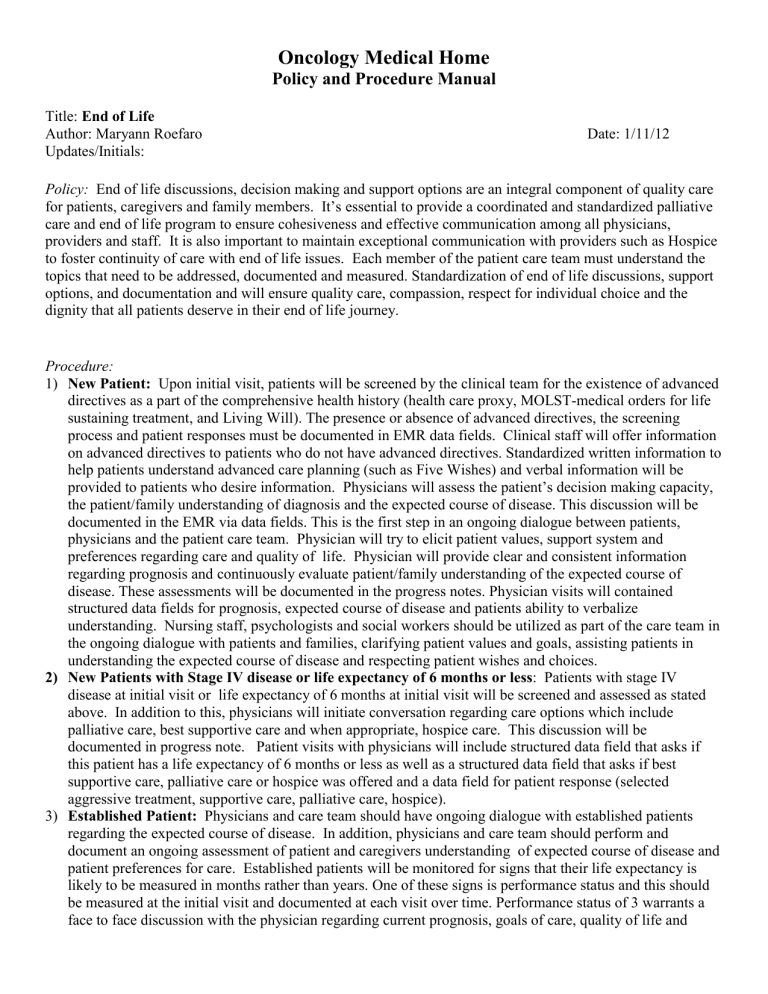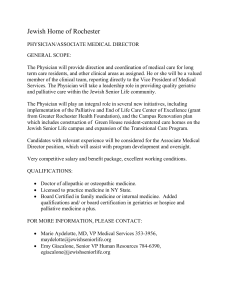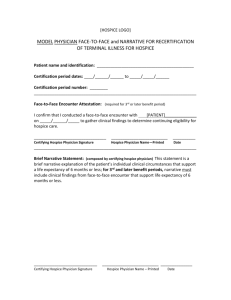End of Life Care - Medical Home Oncology

Oncology Medical Home
Policy and Procedure Manual
Title: End of Life
Author: Maryann Roefaro
Updates/Initials:
Date: 1/11/12
Policy: End of life discussions, decision making and support options are an integral component of quality care for patients, caregivers and family members. It’s essential to provide a coordinated and standardized palliative care and end of life program to ensure cohesiveness and effective communication among all physicians, providers and staff. It is also important to maintain exceptional communication with providers such as Hospice to foster continuity of care with end of life issues. Each member of the patient care team must understand the topics that need to be addressed, documented and measured. Standardization of end of life discussions, support options, and documentation and will ensure quality care, compassion, respect for individual choice and the dignity that all patients deserve in their end of life journey.
Procedure:
1) New Patient: Upon initial visit, patients will be screened by the clinical team for the existence of advanced directives as a part of the comprehensive health history (health care proxy, MOLST-medical orders for life sustaining treatment, and Living Will). The presence or absence of advanced directives, the screening process and patient responses must be documented in EMR data fields. Clinical staff will offer information on advanced directives to patients who do not have advanced directives. Standardized written information to help patients understand advanced care planning (such as Five Wishes) and verbal information will be provided to patients who desire information. Physicians will assess the patient’s decision making capacity, the patient/family understanding of diagnosis and the expected course of disease. This discussion will be documented in the EMR via data fields. This is the first step in an ongoing dialogue between patients, physicians and the patient care team. Physician will try to elicit patient values, support system and preferences regarding care and quality of life. Physician will provide clear and consistent information regarding prognosis and continuously evaluate patient/family understanding of the expected course of disease. These assessments will be documented in the progress notes. Physician visits will contained structured data fields for prognosis, expected course of disease and patients ability to verbalize understanding. Nursing staff, psychologists and social workers should be utilized as part of the care team in the ongoing dialogue with patients and families, clarifying patient values and goals, assisting patients in understanding the expected course of disease and respecting patient wishes and choices.
2) New Patients with Stage IV disease or life expectancy of 6 months or less : Patients with stage IV disease at initial visit or life expectancy of 6 months at initial visit will be screened and assessed as stated above. In addition to this, physicians will initiate conversation regarding care options which include palliative care, best supportive care and when appropriate, hospice care. This discussion will be documented in progress note. Patient visits with physicians will include structured data field that asks if this patient has a life expectancy of 6 months or less as well as a structured data field that asks if best supportive care, palliative care or hospice was offered and a data field for patient response (selected aggressive treatment, supportive care, palliative care, hospice).
3) Established Patient: Physicians and care team should have ongoing dialogue with established patients regarding the expected course of disease. In addition, physicians and care team should perform and document an ongoing assessment of patient and caregivers understanding of expected course of disease and patient preferences for care. Established patients will be monitored for signs that their life expectancy is likely to be measured in months rather than years. One of these signs is performance status and this should be measured at the initial visit and documented at each visit over time. Performance status of 3 warrants a face to face discussion with the physician regarding current prognosis, goals of care, quality of life and
patient wishes. Structured data fields for every PS 3 patient with current prognosis, goals of care for patient discussed check box and listed specific goals of care for the patient. Palliative care/supportive care should be offered as care options. Life expectancy of 6 months or less should warrant discussion about advanced directives for those who have not previously established advanced directives. A standardized tool such as
“Five Wishes” should be used by health care team.
4) Information Exchange with Referring Provider: Copies of new consult notes & progress notes documenting end of life discussions and wishes, recommendations for treatment or palliative care and copies of any new advanced directives will be provided to referring providers.
5) Measurable Compliance – Information technology should be used to measure compliance. New patient visits should be measured and should have documentation of the following: screening for advanced directives, physician discussion with patient and family regarding expected course of disease, patient wishes and goals. New patients with stage IV disease or life expectancy of 6 months or less should have physician documentation of discussion with patient regarding the following: patient values, patient understanding of expected course of disease and discussion of palliative care/supportive care and/or hospice if it is an appropriate option. (Check box for each area) All established patients should have documentation of performance status measurement at each visit. (data field) All patients with performance status of 3 should have documentation of discussion with physician regarding goals of care, quality of life and palliative care, supportive care and hospice when appropriate as option for care. (Check boxes) Practices should measure the number of patients who are treated with chemo or radiation therapy in the last 8 weeks of life. Practices should measure the place of death (home or hospital). Practices should measure the number of days in hospice prior to death.
Responsible Parties: Physicians, Advanced Practice, Social Work, Nursing and other members of the clinical team
Physician
Physician
Date
Date
Physician
Key Leadership
Date
Date









